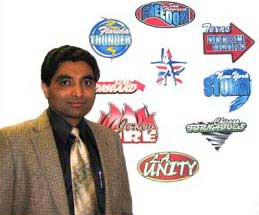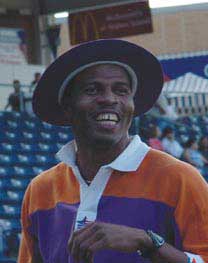Magazine
The ICC Is Not Against Procricket

Kalpesh Patel, the brain and brawn behind ProCricket soldiers on.
|
Kalpesh Patel is the brain (and the brawn) behind ProCricket, the professional league created with the aim of bringing cricket to mainstream America. Ever since he created the league, Patel has faced more criticism and setbacks than praise for his initiative. He has toughed through it all and remains convinced that ProCricket has a great future in America. The ProCricket league, comprising 8 teams, officially began its regular season on July 2, 2004 in New York. It has since held thirteen matches in temporarily retrofitted minor league baseball parks in six cities across the United States, using the three-hour Twenty20 format. In Houston for the Chicago Tornadoes vs. Texas Arrowheads matchup, Kal Patel spoke to Little India about the target audience’s response to ProCricket, reactions of the International Cricket Council (ICC) and the Board of Control for Cricket in India (BCCI) to the new league, and his future plans. What made you take this bold decision of trying to introduce cricket to America? We did some Gallup polls to get an understanding of what can be done, and we believe that this is something that will be successful.
How has the response been so far to the new initiative? So what kind of feedback are you getting from the spectators? What they don’t know is that my business plan allows me to have empty stadiums for three years and we will still continue. After three years if I see empty seats, then something has gone horribly wrong. The positive responses are phenomenal. “We love this game.” “We love the fact that this game is only three hours, that it is in a professional facility, that the amenities are good, that you have concession stands.” I am happy with the fact that whatever the turnover – 200, 500 or 2000 – the ratio is such that there are always 20-30 percent white Americans who have never watched cricket before. What is it, in your opinion, that will attract Americans to these cricket matches? Which network is that? Did you have difficulty roping in international players? It was difficult but not very difficult. We approached them through their agents. We had exactly 104 committed players who wanted to participate in this league, ranging all over England, West Indies, Zimbabwe, Kenya, India, Australia, Sri Lanka and Pakistan. But we realized we needed a set of players who were ticket sellers, people who appeal to the fans, like Franklin Rose, who is an outstanding character. Then Colin Miller, another phenomenal character. He is known as Colin ‘Funky’ Miller. He sometimes dyes his hair to match the color of his uniform. These are the kind of players we got in, so we can get families to come and watch. But then along came the issue of the BCCI, which actually tarnished everything. Even after this, S K Nair (secretary of the BCCI) sent out a letter saying any player participating in ProCricket in America will have to face severe consequences. This included Ranji players, players who were never going to make the Indian team because they were too old, even players that were fourth string on the Ranji team. So we contacted the ICC yet again (chuckles) and told them, without naming any countries, that one or more of your national boards has misconstrued your release. They knew exactly what we were talking about. So they sent yet another letter and this went to S K Nair personally, with a carbon copy to myself. It said, “We believe that you have misconstrued our directive. When we said contracted players, we meant only your national players on the current team. ALL the other players are ALLOWED to play in ProCricket.” If that is the case, why do you think the BCCI reacting like this? So there are absolutely no Indian players here in the U.S. now? How about the boards of other countries? Have they posed any objections? What exactly is the stand of the United States of America Cricket Association (USACA)? I met with the USACA in Dallas on June 19, despite that being the day of our inaugural exhibition match in New Jersey. The meeting itself was very positive. I made it very clear to them that we are not competing with them. We are a completely different organization. They are a not-for-profit organization that is running cricket under the ICC purview and promoting the game of 50 overs and Test matches. We are a for-profit organization, a sports marketing company in America, and we are not under the ICC or USACA purview. We are basically for cricket as a form of entertainment, to draw crowds, to get families and little kids to come and watch the game. And if we end up making cricket popular, the USACA will benefit from it too.
In the end, the president, Gladstone Dainty, said that he was pleased with the plan, but that it was for the USACA Board to decide if they wanted to go along with us. We have not heard from them till date. How did you manage to get Anshuman Gaekwad involved? What is his role in your organization? How are the international players assigned to the different teams? Are they contracted to a particular team? So how do they like the experience of playing this form of cricket on this kind of stage? Where do you see yourself over the next few years? Like I said earlier, my business plan is for three years. It is not a two-month plan. It is actually a 10-year plan, just like any other business. We have a lot of people lined up for sponsorships. But we are waiting for the product to be complete. After the end of the third year, I may have to see some returns from the tickets. At the end of the third year, based on my plan, I expect about 40 precent of the crowd to be mainstream American spectators. The way we are going to market it, I am confident we will be able to get there. Incidentally, we have also been approached by Fox World International to broadcast our matches in South America, Australia, England, Hong Kong and parts of Africa. It is all going fine. There are few clouds out there. When they go away it will be sunny, and we will be all right. We are almost half way through the season this year. Next year will be a better season. |


